Embraer EMB-120RT
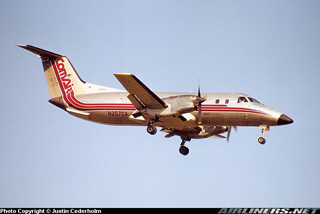
Photo copyright Justin Cederholm - used with permission
Comair Flight 3272, N265CA
Monroe, Michigan
January 9, 1997
On January 9, 1997, an Embraer EMB-120RT, N265CA operated by COMAIR Airlines, Inc. as Flight 3272 from the Cincinnati/Northern Kentucky International Airport, crashed during approach following an uncommanded roll excursion and rapid descent near Monroe, Michigan. All 26 passengers and three crew members were killed. The airplane was destroyed by ground impact forces and post-accident fire. The NTSB determined that a combination of ice accumulation on the wings and low airspeed with flaps retracted resulted in adverse effects on both lift and drag, leading to a loss of control after automatic disconnection of the autopilot. The airplane entered an extreme nose-down pitch attitude from which the crew was not able to recover.
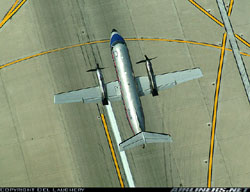
Photo Copyright Del Laughery - Used with permission
An Embraer EMB-120RT, US registration number N265CA, was manufactured by Embraer in Brazil in December 1991, and delivered to Comair. On February 20, 1992, the airplane received a U.S. Standard Certificate of Airworthiness from the FAA and was put into service as part of Comair's fleet.
On January 9, 1997, Flight 3272, operated by Comair Airlines under the provisions of Title 14 Code of Federal Regulations (CFR) Part 135, departed as a scheduled, domestic passenger flight from the Cincinnati/Northern Kentucky International Airport (CVG) in Covington, Kentucky to Detroit Metropolitan/Wayne County Airport (DTW) in Detroit, Michigan. The flight departed CVG about 1508 local time, with two flight crew members, one flight attendant, and 26 passengers on board.
Instrument meteorological conditions (IMC) prevailed at the time of the accident, and the flight was operating on an instrument flight rules (IFR) flight plan. The IFR flight plan indicated that Flight 3272's final cruise altitude would have been flight level (FL) 190; however, the pilots requested and received clearance to climb to FL 210 to avoid turbulence at the lower altitude.
History of Flight
Following a departure that was delayed due to servicing and de-icing requirements, Comair Flight 3272 was uneventful until arrival in the Detroit terminal area. The flight crew obtained Detroit's automatic terminal information service (ATIS) information that indicated visibility of one mile in light snow and included the remarks, "braking action advisories in effect" and "local ground de-ice procedure in effect."
Detroit approach control requested Flight 3272 to reduce airspeed to 190 knots, descend, and maintain an altitude of 7,000 feet. During the descent, passing through about 8,600 feet, the first officer called for the descent checklist that included an ice protection prompt (to be accomplished before the airplane entered icing conditions). Comair's EMB-120 flight standards manual (FSM) states that "icing conditions exist when the outside air temperature (OAT) is +5 degrees Celsius or below and visible moisture in any form is present (such as clouds, rain, snow, sleet, ice crystals, or fog with visibility of one mile or less). Neither pilot specifically called for the approach checklist. The approach briefing is the first item on the approach checklist. The last two items of the approach checklist; notify flight attendants, and set flaps to the approach setting, were typically accomplished later during the approach when the airplane was closer to its destination airport. Cockpit Voice Recorder (CVR), Flight Data Recorder (FDR) information, and physical evidence indicated that the flaps were in the retracted position when the accident occurred.
View Comair Flight Path Animation below:
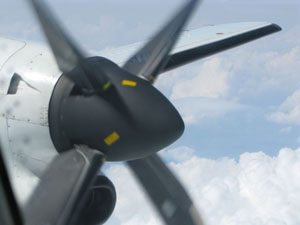
Following level-off at 7000 feet, the flight crew received instructions to further reduce speed to 170 knots and descend to 6000 feet. The final approach controller informed the flight that they would be receiving vectors for traffic spacing, and then instructed the flight to descend to 4,000 feet. This was followed shortly by instructions to turn to a heading of 180 degrees, and further reduce airspeed to 150 knots. Final instructions to the flight were to turn further left to a heading of 090 degrees. Following this final instruction, the control wheel position (CWP), roll attitude, and magnetic heading indicated that the airplane began a left turn and was in a shallow but steepening left bank at 4,000 feet. The autopilot mode changed from "Altitude Pre Select (Arm)" to "Altitude Hold" mode. As bank angle increased through 23 degrees, the CWP moved to the right, indicating the autopilot's attempt to correct the increasing roll; however, the bank angle continued to increase. At about this same time, engine torque values began to increase from flight idle, and the FDR recorded split engine torque values, with higher torque values recorded for the right engine than the left. This split continued until the autopilot disengaged. The airplane's left roll attitude increased beyond 45 degrees, airspeed decayed to 146 knots, as the stick shaker (stall warning) activated, and the autopilot disconnected. Following autopilot disconnect, roll attitude rapidly increased to 140 degrees and the airplane pitched down to -17 degrees. Airplane pitch continued to decrease until reaching -50 degrees, and left roll increased to more than 140 degrees. (View NTSB Comair Re-creation Animation below.)
The airplane struck the ground in a steep nose-down attitude in a level field in a rural area about 19 nm southwest of DTW. Fragmented airplane wreckage was found in and around three impact craters, with airplane debris located up to 340 feet from the largest impact crater. The complete NTSB report on this accident is available here: (NTSB Report)
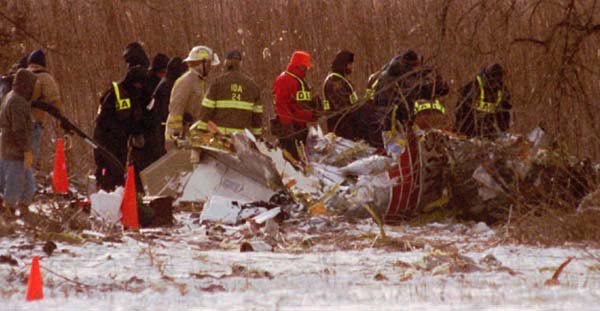
Ice Protection System
The EMB-120 was certified for operation in icing conditions as specified in Appendix C to 14 CFR part 25, specifically, 14 CFR 25.1419. During certification testing in both natural icing conditions, and with artificial ice shapes installed on the airplane, the airplane was demonstrated to be in compliance with the applicable regulations relative to operations in icing conditions.
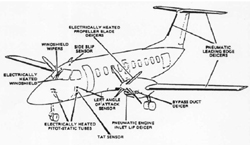
View Larger
The EMB-120 ice protection system includes electrical anti-icing for the windshields, pitot/static tubes, static ports, and the angle of attack, sideslip, and total air temperature sensors. The propeller blades are electrically deiced, and the leading edges of the wings, horizontal and vertical stabilizers, the engine inlets, and the engine bypass ducts are protected by pneumatic deicing boots.
According to their manufacturer, the pneumatic boot system protecting the wings and tail surfaces operates on engine bleed air and is intended to remove ice that forms on the protected surfaces by inflating the rubber boots. Engine bleed air operating through flow control valves causes the boots to cyclically inflate and deflate. When the boots inflate, accumulated ice is cracked and removed by the airstream. The wing boots are divided into three spanwise segments, with tubes in each segment oriented span-wise along the leading edges.
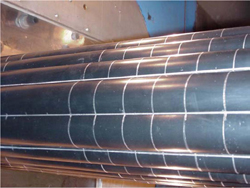
As configured at the time of the accident, the system was controlled by a timer select switch and a cycle switch, both located in the flight deck. The cycle switch was a two-position switch selectable for heavy or light icing conditions.
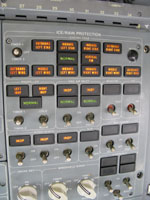
Control Panel
View Larger
When operating, if a "heavy" cycle is selected, the boots are cyclically inflated for six seconds, and deflated for 54 seconds. If "light" is selected, the deflation time is increased to 174 seconds between inflation cycles. Inflation is symmetric, beginning with the most outboard wing segments, moving to the middle and inboard boots, then sequencing through the other protected areas of the airplane before beginning the sequence again for as long as the system is turned on. A system description excerpted from the Embraer Maintenance Manual, including a system schematic, is available at the following link: (Embraer AMM)
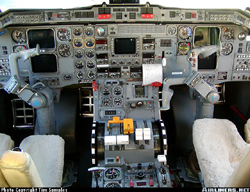
Photo copyright Tim Samples - used with permission
View Larger
The stall warning system was not designed to communicate with the anti-ice system, and there was no stall warning bias (earlier stall warning) following an icing encounter or during deice system operations, nor was one required by regulation. Some airplanes incorporate a bias in the stall warning system such that if the ice protection system is activated any time during the flight, the bias is invoked and stall warning is shifted to a higher speed. This results in an earlier stall warning based on and proportional to the increase in stall speed associated with ice accumulation in order to compensate for the stall speed increase.
Previous Events and Manufacturer's Follow-up Actions
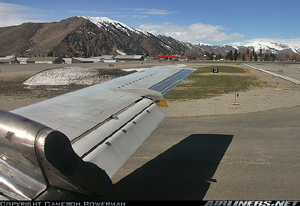
Photo copyright Cameron Bowerman - used with permission
Prior to the accident there were six icing related incidents between June 1989 and April 1995. All six events involved uncommanded speed reductions, some to stall warning, and roll upsets. The associated investigations concluded that all six events were the result of ice accumulations on the wing. In some of the events, the flight crew had observed ice accretions on the wings, but did not believe that accumulation was sufficient to activate the ice protection system. In other events the flight crew failed to recognize that they were in icing conditions and, therefore, did not activate the ice protection systems. The six events are detailed in the Precursors section of this summary.
Following the October 31, 1994 crash of an ATR-72 in icing conditions, near Roselawn, Indiana, the FAA conducted a review of in-service incidents related to upsets in icing conditions. The review encompassed about 50 events, including the six previously identified EMB-120 events. Following this review on November 7, 1995, the FAA held a meeting attended by the Brazilian Centro Técnico Aerospacial (CTA), the Airline Pilots Association (ALPA), Embraer, the NTSB, and EMB-120 operators, including Comair. At this meeting the results of controllability testing accomplished on the EMB-120 in supercooled large droplet (SLD) icing conditions were discussed. The FAA also made a presentation summarizing the six previous in-service events and discussed with the attending parties possible remedial actions that could be taken to mitigate operational issues when flying in icing conditions, and the characteristics of the airplane when ice is accumulated on the airframe without the activation of the de-ice system.

Photo of Wreckage of Comair Flight 3272 - NTSB docket photo (right)
Following the FAA meeting, Embraer, on November 15, 1995, held a Flight Crew Awareness seminar for all EMB-120 operators. The six previous in-service events were discussed in detail. The stated purpose of the seminar was to discuss operation of the EMB-120 in icing conditions, to generate recommendations for a flight crew awareness program, and to discuss the operational documentation (flight manual and flight crew operations manual) regarding operations in icing conditions.
The seminar resulted in a number of recommendations. Among those were recommendations to modify the FAA-approved Airplane Flight Manual (AFM) to emphasize recommend operational speed increases in icing conditions, distribution of an Operational Bulletin detailing specific modes of operation in icing conditions, including autopilot usage, operational speeds, proper use of ice protection systems, stall warning, and refined definitions of, and means to identify, icing conditions and formation of ice.
In December 1995, Comair issued an interoffice memo to all EMB-120 flight crew members discussing the major factors that had resulted in the controllability problems experienced by other operators in the six in-service events. The memo cited the primary causes as lack of airspeed control, use of the autopilot in a vertical mode that resulted in airspeed deviations, and failure to recognize ice accumulations and use the ice protection system. The memo further issued instructions that in icing conditions, autopilot use should be restricted to a single (Indicated Airspeed) mode (IAS mode), which would initiate a descent if proper airspeed could not be maintained, and would maintain proper stall margins. Operational speeds were increased in icing conditions to a minimum airspeed of 160 knots, and 170 knots when airframe ice was present. It also recommended close monitoring of airspeed, especially in turns.
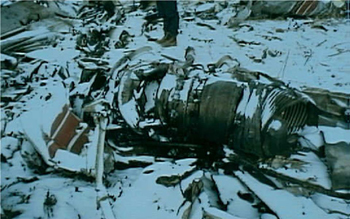
In April 1996, Embraer published Operations Bulletin 120-002/96, which provided results of SLD testing and a general discussion of EMB-120 operations in icing conditions. The bulletin was distributed to Embraer operators and additionally to various FAA certification and aircraft evaluation groups, and many FAA flight standards offices. Guidance in the bulletin regarding ice accretions formed in non-SLD conditions without activation of the de-ice system, described a drag increase associated with ice accretion that required an increase in angle of attack to maintain altitude. The increase in angle of attack in that condition could potentially lead to a stall and uncommanded roll excursions. Stall would occur at a "speed somewhat above" a normal stall speed.
Finally, on April 23, 1996, Embraer issued AFM revision 43, which revised icing procedures to activate the de-icing system at the first signs of ice formation. Based on a concern related to ice bridging that might be caused if the de-icing system was activated too early in icing conditions, Comair decided not to incorporate the contents of AFM revision 43 into their operations manual or training procedures.
Icing Related Procedures
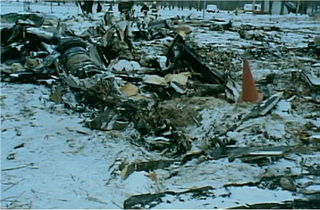
Prior to these in-service incidents, the FAA approved Airplane Flight Manual (prior to revision 43), produced by Embraer, and Comair's Flight Standards Manual (FSM - the Comair equivalent of the AFM) allowed by 14 CFR 121.133 and .141, containing icing procedures that advised delaying actuation of deicing boots until a specific ice thickness (¼ to ½ inch) had accumulated on the wing. The Comair FSM recommended an ice accumulation of approximately ½ inch prior to activation of the deicing boots. It also added that when it was difficult to see the wing leading edge or it was night, that a speed decay of 10 to 15 knots was a "good indicator of ice accumulation." (Comair FSM) Embraer's Revision 43 to the EMB-120 AFM changed this guidance, and recommended activation of wing and tail deicing boots "at the first sign of ice formation." As stated previously, Comair elected not to incorporate the AFM recommended procedural changes into their operational procedures.
Ice Bridging
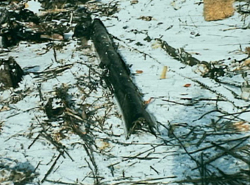
NTSB docket photo
The specified delay in deicing system activation was based on a long-standing, industry-wide, historical assumption related to the potential for ice bridging on early deice boot designs, and a means by which it could be avoided. The occurrence of ice bridging, where the deicing boots deform but don't break accumulated ice would render the system ineffective and prevent ice removal. It was believed that waiting for an ice accumulation of a sufficient thickness would always result in ice removal and avoid the possibility of bridging. Testing conducted after the accident revealed that there was no evidence of ice bridging on the EMB-120. Further, the testing led to conclusions that the duration of the system cycle times was such that, if bridging was a problem, it might occur during an intercycle interval (from one to three minutes, depending on system setting). There was no in-service data indicating that ice bridging was ever encountered, leading to the eventual conclusion that ice bridging was not a problem for the EMB-120. As a result, in April 1996, Embraer issued AFM Revision 43 which recommended boot activation at the first sign of ice on the aircraft, and after the accident, led to industry wide recommendations that deicing systems be activated immediately upon entering icing conditions.
An animation describing ice bridging is available below:
Post-Accident Testing
Following the accident, a number of studies were conducted by Embraer, to measure performance and handling effects of both the thrust asymmetry resulting during the accident sequence, and the drag levels associated with various ice accumulations. Further, in separate studies, the NTSB contracted with NASA-Lewis, and the FAA contracted with the University of Illinois, Urbana-Champaign (UIUC) to investigate various icing related characteristics. The results of the noted tests are included in the NTSB accident report for this accident.
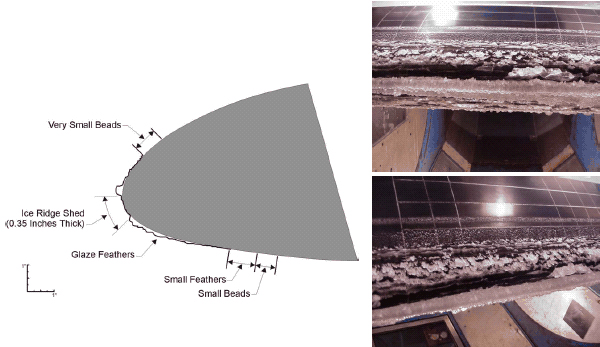
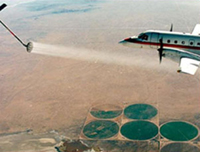
Communication Lapses
The NTSB noted that the EMB-120 had exhibited a history of icing-related incidents prior to the Comair accident. Following the noted incidents, Embraer had issued, and the FAA had approved, an AFM revision that changed operational procedures in icing conditions. The AFM revision was distributed to all EMB-120 operators and to the FAA. Comair subsequently elected not to incorporate the revised procedures into their company operations manual, in part due to their earlier issuance of a company memo on December 8, 1995, advising pilots not to operate at airspeeds below 160 knots in icing conditions, and to observe a minimum airspeed of 170 knots when climbing on autopilot or holding in icing conditions. The memo had been issued in response to the previously discussed November 1995 meetings. Other reasons cited by Comair for not adopting the AFM revision were conflicts with Comair's trained procedures and practices, specifically with practices regarding ice bridging. Comair concluded that the revised procedures were potentially unsafe.
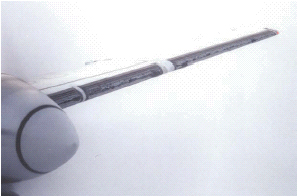
This December 1995 memo was distributed to all Comair pilots but was not subsequently incorporated into a flight standards bulletin (FSB) or a revision to Comair flight standards manual until a flight standards bulletin was issued in October 1996. The NTSB noted that the FSB did not repeat the earlier memo's blanket 160 knot minimum airspeed in icing conditions and used different language and airspeeds than the earlier memo. These factors, coupled with Comair's methods of distribution and failure to incorporate the information as a permanent revision to the FSM, may have resulted in confusion among flight crews regarding appropriate airspeeds in icing.
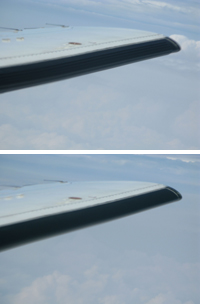
Upper photo, boots inflated. Lower photo, boots deflated.
View Larger: Image 1, Image 2.
Ultimately, the NTSB criticized the FAA for not having required adoption of AFM revision 43 into Comair's AFM or incorporation into company procedures. They cited FAA's lack of internal coordination regarding the safety implications of AFM revision 43 as a crucial factor in the chain of events leading to the accident, and recommended development of an organizational structure and communications system to ensure effective continuing airworthiness oversight.
The NTSB concluded that at the time of the accident, FAA personnel, specifically the Comair POI, "lacked information critical to the continued safe operation of the EMB-120 fleet and would have been unable to evaluate the need to incorporate AFM revision 43 or any alternatives proposed by air carriers." The NTSB stated the belief that flight standards personnel at all levels needed to be informed about all manufacturer operations bulletins and AFM revisions, including background and justification for revisions. As a result of the NTSB finding, FAA internal procedures have been revised, and AFM revisions are now coordinated between all pertinent FAA offices.
In November 2006, the DOT/FAA Office of Aviation Research and Development released a report detailing their investigation into the performance of pneumatic deicing boot systems, surface ice detectors, and quantified information regarding intercycle ice.
The NTSB issued 34 findings relative to this accident, and cited the probable cause as:
"FAA's failure to establish adequate aircraft certification standards for flight in icing conditions, the FAA's failure to ensure that a Centro Tecnico Aerospacial/FAA approved procedure for the accident airplane's deice system operation was implemented by U.S.- based air carriers, and the FAA's failure to require the establishment of adequate minimum airspeeds for icing conditions, which led to the loss of control when the airplane accumulated a thin, rough accretion of ice on its lifting surfaces."
The NTSB also cited the flight crew's decision to operate in icing conditions near the lower margin of the speed operating envelope as a contributing factor in the accident.
The most pertinent findings are associated with:
- deficiencies in the icing certification standards, and
- critical communication among all major parties involved in the certification and operation of a transport airplane
The complete text of the findings can be accessed at the following link: (NTSB Findings)
The NTSB issued recommendations to the FAA and NASA on a wide range of subjects. Of primary concern to the NTSB was the lack of internal FAA coordination regarding AFM and/or operations manual revisions. Other subjects addressed included:
- FAA icing criteria and certification testing
- Consistency between AFM and carrier operations manuals, in particular with regard to icing related procedures
- Operations in icing conditions
- Training for flight in icing conditions
The complete text of the recommendations can be accessed at the following link: NTSB Safety Recommendations
14 CFR 25 Appendix C - Defines the icing envelope for which certification evaluations must be conducted if certification for flight in icing conditions is desired.
14 CFR 25.1419 - Defines the compliance criteria for icing certification.
At the time of this accident there was an industry-wide belief that for deicing (boot) systems to effectively remove ice from protected surfaces, an ice buildup to a discrete thickness was required. This necessitated flight crews being aware that they were in icing conditions and being able to accurately assess the amount of ice buildup on the airplane. Once the procedurally recommended thickness had been attained, the system could be activated, and the ice would be removed.
There was a concern throughout the industry that premature actuation of the deicing system would result in a phenomenon known as ice bridging, which would result in plastic deformation of newly formed ice, and formation of a "bridge", or void, between the boots and the accreted ice. The ice bridge would be the same shape and volume as the expanded deicing boots, effectively forming a new wing leading edge. As the ice bridge would basically be a mold of the expanded deicing boots, the deicing system would become ineffective at removing the ice, and the contamination would continue to accrete on this bridged section of wing. Over a relatively short time period in icing conditions, ice could then build on top of this "bridge" to a thickness sufficient to produce profound effects on airplane performance and handling.
Subsequent to this accident, several studies concluded that for the modern class of deicing boot systems, activation of a boot deicing system at the first indication of icing conditions (prior to any actual ice accretion) would prevent ice accumulation and provide better protection for the wing. A 1997 icing conference addressed the subject of ice bridging and disseminated these conclusions to industry at large, resulting in recommendations to activate deicing systems upon entry into icing conditions, and many operators/manufacturers have adopted this philosophy.
Article on ice bridging, © Aviation International News Online, April 1, 2007.
- Delayed boot activation until prescribed amount of ice has accreted on the airplane.
- Operation at lower than prescribed speeds in icing conditions.
- Reliance on flight crew to accurately assess quantitative accretion thicknesses as basis for activation of ice protection system.
- Delayed activation of ice protection system vital to proper system performance (prevented ice bridging)
- Flight crew was able to accurately assess prescribed levels of ice accretion required for system activation
Prior to the accident, there were six icing related incidents involving EMB-120 aircraft. Excerpted from the NTSB report and details of the incidents are as follows:
" In April 1995 near Tallahassee, Florida, an EMB-120 was in cruise flight at FL 250 when the pilots noticed the airspeed decrease from 180 KIAS to 140 KIAS and pitch increase to 5o nose up with only trace icing observed on the leading edge of the wing. They activated the deice boots; the airspeed subsequently increased, and the pitch decreased.
On October 16, 1994, near Elko, Nevada, an EMB-120 was in cruise flight at 13,000 feet msl, at 160 KIAS. The pilots checked for ice on the wings and propeller spinners but did not see a significant amount. Moments later, as they entered a right bank with the autopilot engaged, the stick shaker and pusher activated. The pilots resumed manual control of the airplane and recovered. Post-flight inspection of the aircraft revealed clear ice on the leading edge and spinner. The deice boots were not activated during the flight because the crew did not believe the ice was of sufficient thickness. Review of the FDR data indicated that the airplane's airspeed had decreased to 138 KIAS before stick shaker activation.
On April 23, 1993, at Pine Bluff, Arkansas, while climbing on autopilot, an EMB-120 stalled and experienced an upset event and subsequent separation of propeller blades. FDR data indicated that the airplane's airspeed had decreased to 138 knots before stick shaker activation and autopilot disconnect. The Safety Board concluded that an accretion of ice on the wing was the only reasonable explanation for the occurrence of stick shaker activation and subsequent loss of roll control at higher-than-expected airspeeds. There was no evidence that any ice protection systems were activated before, during, or after the upset, and the flight crew did not recall seeing evidence of icing before the loss of control.
On November 22, 1991, in Clermont-Ferrand, France, an EMB-120 was in an autopilot-controlled descent when the captain disconnected the autopilot manually to slow the descent, stabilizing the aircraft at 4,500 feet. FDR data indicated that the airplane's airspeed decreased to 150 KIAS, the stick shaker activated, the airplane rolled to the right and lost about 1,000 feet of altitude. During recovery, the engine power was increased and the deice boots were cycled by the first officer. Post-flight inspection revealed clear ice on the horizontal stabilizer, wing tips, and inboard section of the wing.
In September 1991 at Fort Smith, Arkansas, an airplane was in level flight with the autopilot engaged at 19,000 feet msl when the pilots felt vibration through the floorboards. The pilots inspected the wings, propeller spinners, and engine inlets for ice, but did not observe excessive amounts of accumulation. Thirty seconds after the first vibration, the stick shaker activated, and the captain called for all ice protection equipment to be turned on. The airplane entered a right bank, nose-down descent; the pilots regained control at 16,000 feet msl.
On June 28, 1989, at Klamath Falls, Oregon, an EMB-120 was operating at 16,000 feet msl in icing and turbulence with the autopilot engaged. When the airplane descended to 15,000 feet msl, the pilots observed light mixed rime and clear ice followed by a rapid decrease in airspeed from 180 to 160 KIAS, stick shaker activation, and an uncommanded roll/upset. The pilots resumed manual control of the airplane and applied maximum power; they stabilized the airplane at 12,000 feet msl. Both pilots reported that the airplane was operating in light icing conditions when the upset occurred. Although the pilots reported light icing, Air Line Pilots Association's (ALPA) report of this incident stated that a United Airlines Boeing 727 flight engineer occupying seat 3C in the cabin described the icing conditions as "moderate" and indicated that up to one inch of ice may have accumulated on the wing leading edges. There was no indication in the FDR data or the ASRS report that any ice protection equipment was used."
Following these incidents, in the fall and winter of 1995, Embraer conducted a series of EMB-120 controllability tests to evaluate the airplane in super-cooled large droplet (SLD) icing conditions. Also in November 1995, Embraer presented the results of these tests at a flight crew awareness seminar. In December 1995, Comair issued the previously discussed interoffice memo entitled "Winter Operating Tips," and Embraer conducted icing tanker tests in SLD conditions. In April 1996, Embraer distributed Operational Bulletin 120-002/96, which suggested in part that deicing boots be activated at the first sign of ice accretion. Later the same month, Embraer produced AFM Revision 43, and in May 1996, the FAA issued Airworthiness Directive AD 96-09-24, mandating requirements of SLD conditions. In July 1996, Comair issued Flight Standards Bulletin 96-02 titled "Severe Icing Conditions" followed in October by Flight Standards Bulletin 96-04 titled "Winter Flying Tips."
The FAA has issued Notice of Proposed Rulemaking (NPRM) Docket No. FAA-2007-27654, which proposes to amend the airworthiness standards applicable to transport category airplanes certificated for flight in icing conditions. The proposed standards would require a means to ensure timely activation of the airframe ice protection system. This proposed regulation is the result of information gathered from a review of icing accidents and incidents and is intended to improve the level of safety for new airplane designs relative to operations in icing conditions. Comments on the proposed rule have been received, and the rulemaking process is continuing, pending adoption of the final rule.
The proposed rulemaking would amend 14 CFR part 25 by adding specific requirements for airplane performance and handling qualities for flight in icing conditions. Further, the proposal amends § 25.1419 to address certification approval for flight in icing conditions for airplanes without ice protection features. Those proposed changes do not impact this rulemaking. However, this rulemaking may result in minor conforming changes to the airplane performance and handling qualities for flight in icing conditions. In consideration of the foregoing, the FAA proposes to amend part 25 of Title 14, Code of Federal Regulations, as follows:
§ 25.1419 Ice Protection.
(e) One of the following methods of icing detection and activation of the airframe ice protection system must be provided:
(1) A primary ice detection system that automatically activates or alerts the flight crew to activate the airframe ice protection system.
(2) A definition of visual cues for recognition of the first sign of ice accretion on a specified surface combined with an advisory ice detection system that alerts the flight crew to activate the airframe ice protection system.
OR
(3) Identification of conditions conducive to airframe icing as defined by an appropriate static or total air temperature and visible moisture for use by the flight crew to activate the airframe ice protection system.
(f) Unless the applicant shows that the ice protection system need not be operated during specific phases of flight, the requirements of paragraph (e) are applicable to all phases of flight.
(g) After the initial activation of the ice protection system-
(1) The ice protection system must operate continuously.
(2) The airplane must be equipped with a system that automatically cycles the ice protection system; or
OR
(3) An ice detection system must be provided to alert the flight crew each time the ice protection system must be cycled.
(h) Procedures for operation of the ice protection system must be established and documented in the Airplane Flight Manual.
Communication
The NTSB cited breakdowns in information flow among the FAA, the operator, and the airplane manufacturer as a causal factor in the Comair accident. Embraer had issued an AFM revision that required activation of ice protection immediately upon entering icing conditions and increases in operating speeds when in icing conditions. However, the FAA had not mandated incorporation of the revised AFM material into air carrier operations. The NTSB stated that if these operational changes had been made mandatory by the FAA, the accident would not have occurred.
Recognizing the need for improved authority-to-authority communication, on September 26, 2006, the FAA released Order 8040.5 describing the policy and procedures for developing Federal Aviation Administration (FAA) airworthiness directives (AD) on imported products where the State of Design Authority has issued mandatory continuing airworthiness information (MCAI). The order introduced a process for evaluating all MCAI and determining whether individual MCAI meet certain criteria that would permit a quicker issuance of an FAA AD.
Further, the FAA has implemented a process for Continued Airworthiness Notification to the International Community (CANIC) that provides notification to other international regulatory authorities when the FAA issues an airworthiness directive. This is the reciprocal action to that identified above in FAA Order 8040.5. Further, the FAA has instituted a process of regular continued operational safety program reviews with all manufacturers who hold, or have applied for, FAA type certificates on their aircraft. This review program allows a more open and consistent avenue of communication between the FAA, counterpart regulatory authorities, and manufacturers, should airworthiness issues arise.
The Agência Nacional de Aviação Civil (ANAC) (Brazilian Authority) issued the following ADs related to EMB-120 icing:
- AD 97-06-03R1: This AD mandates the installation of ice detectors.
- AD 2001-05-02: This AD prohibited the use of autopilot whenever entering ice conditions (Superseded by AD 2001-05-02R1).
- AD 2001-05-02R1: This AD relieves the prohibition of using the autopilot in icing conditions, provided a low-speed visual/aural alarm system is installed (Superseded by 2001-05-02R2).
- AD 2001-05-02R2: This AD imposes a modification to the existing low-speed visual/aural alarm system.
The FAA issued the following ADs related to EMB-120 icing:
- 96-09-24: This AD requires revising the Airplane Flight Manual (AFM) to provide the flight crew with recognition cues for and procedures for exiting severe icing conditions, and to limit or prohibit the use of various flight control devices.
- 98-15-22: This AD requires a one-time inspection for delamination, erosion, and condition of fillet sealant and conductive edge sealer of the wing and empennage leading edge area behind the de-ice boots, and follow-on corrective actions.
- 2001-06-18: This AD requires revising the AFM to include requirements for activation of the ice protection systems, and to add information regarding operation in icing conditions; installing an ice detector system; and revising the AFM to include procedures for testing system integrity. This AD also requires installing the ice detector system in accordance with revised procedures.
- 2001-20-17: This AD requires revising the AFM, installing a placard on the main instrument panel, and removing the "LIGHT-HEAVY" inflation switch of the leading-edge deicing boots. This amendment continues to require those actions and adds requirements to install a low-speed alarm for icing conditions, to revise the AFM, and to replace an existing placard with a placard that directs the flight crew to activate the deicing boots whenever ice is detected by visual cues or ice detector illumination.
- 2007-26-21: Icing tunnel tests on an EMB-120 wing section, conducted under a joint Embraer-NASA-- FAA-CTA (Centro Tecnico Aeroespacial) research program well after the EMB-120 was type-certificated, have shown that stick-shaker-to-stick pusher speed margins may drop below the minimum required by the applicable regulations in certain icing conditions. Although flight tests have shown that the aircraft handling qualities are not adversely affected, these reduced speed margins may significantly increase crew workload in certain flight phases. In order to preserve the original certification stick-shaker-to-stick-pusher-margins when operating under the newly defined intercycle icing conditions, an upgraded stall warning computer with new settings for shaker firing angle-of-attack is required to be installed.
Airplane Life Cycle:
- Operational
Accident Threat Categories:
- Inclement Weather / Icing
- In-flight Upsets
Groupings:
- Loss of Control
- Automation
Accident Common Themes:
- Organizational Lapses
- Flawed Assumptions
Organizational Lapses
Prior to this accident, Embraer issued an AFM revision to recommend increases in minimum operating speeds in icing, and to advise immediate activation of the ice protection system, rather than the delayed activation specified in existing versions of the AFM. The Brazilian regulatory authority and the FAA did not issue airworthiness directives to require adoption of the modified procedures, and Comair, citing conflicts with existing procedures and training and a concern that the revised procedures would promote ice bridging, elected not to incorporate the revision into their AFM or into operating procedures. Further, while background information was available that substantiated the safety enhancements associated with early activation of deicing boots, this information was not widely distributed or known.
Flawed Assumptions
At the time of this accident, there was a prevalent belief throughout the industry that deicing boots would be ineffective if operated too early during an icing encounter. The concern was centered around the formation of an ice bridge over the boot that would prevent removal of ice. Accordingly, procedures related to operation of boot systems required delaying system activation until a sufficient thickness of ice (normally from ¼ to ½ inch) had accumulated. Following the accident, procedures were modified to require activation of deicing boots at the first indication of icing.
Simmons Airlines American Eagle Flight 4184, near Roselawn, Indiana
On October 31, 1994, an Avions de Transport Regional, Model 72-212 (ATR-72), registration number N401AM, crashed during descent after uncommanded roll excursions and a loss of control. This aircraft was leased to and operated by Simmons Airlines, Incorporated, and doing business as American Eagle Flight 4184.
Prior to the approach into Chicago, Illinois (ORD), the airplane was in a holding pattern, in icing conditions, and was descending on autopilot control to a newly assigned altitude when uncommanded roll excursion occurred without warning. The roll excursions were precipitated by an airflow separation forward of the ailerons, and uncommanded aileron deflection resulting from an aileron hinge moment anomaly resulting from ice accretion forward of the ailerons and aft of the trailing edge of the deicing boots.
See accident module
Technical Related Lessons:
Certain classes of airplanes that are certified to operate in Appendix C icing conditions will retain sufficient operational safety margins only if icing protection systems are activated immediately upon encountering icing conditions. These airplanes may also require flight deck annunciation of icing conditions. (i.e., ice detector) (Threat Category: Inclement Weather/Icing)
- Due to concerns for "ice bridging" on the de-icing boots, operational procedures initially required delaying activation of the ice protection systems until a specific ice thickness had accumulated. It was later determined as a result of this accident that activation of the ice protection system at the first indication of icing is effective at preventing the degraded margins and handling qualities. Consequently, procedures were modified to require more timely system activation. In addition, an ice detector system, to alert the crew to icing conditions, was subsequently required for the EMB-120.
On transport airplanes, use of ice protection systems should not be predicated on crew monitoring the degree of ice build-up in order to assess need for system actuation. (Threat Category: Inclement Weather/Icing)
- At the time of the Comair accident, it was believed within the aviation community that activation of deicing boots should be delayed until a specified ice thickness had accumulated on the wings. The origin of this procedure was related to the belief that ice bridging could occur if the system were activated prematurely. This made the timing for system activation dependent upon the flight crew's assessment of ice thickness. After the accident, subsequent testing revealed that the concern for ice bridging was unfounded for this class of boot system. Therefore, procedures were modified to activate the system at the first indications of ice, thereby clarifying the activation criteria, and removing crew judgment as to the thickness of accumulated ice.
Common Theme Related Lessons:
If certified operational characteristics/procedures are shown to be hazardous, regulatory actions should be taken to correct unsafe conditions. (Common Theme: Organizational Lapses)
- This accident was preceded by six in-service incidents related to accumulations of ice, and non-activation of the ice protection system. The manufacturer issued new procedures related to ice protection system activation, and minimum operating speeds in icing conditions. Due to differences in the regulatory and oversight functions within the government of Brazil (the country overseeing the manufacturer of the Embraer EMB-120 airplane), and the government of the United States (the country overseeing the operation of Comair), confusion existed regarding the necessary steps that should be taken in order to change existing operational procedures of the EMB-120 fleet. Consequently, neither regulatory authority (ANAC or FAA) issued airworthiness directives to require incorporation of the revised procedures into air carrier operations until after the accident.
Important safety information provided by the airplane manufacturer should have comprehensive, and timely, distribution to all organizations/individuals responsible for acting upon this information (Common Theme: Organizational Lapses)
- Based on the six in-service incidents, and a series of meetings and operator seminars, the airplane manufacturer issued an AFM revision to update operational procedures and speeds related to icing conditions. Comair elected not to incorporate the AFM revision into their operations and did not provide a copy of the revision to their Principal Operations Inspector (POI). Due to unclear roles and responsibilities of the various FAA offices involved in oversight, FAA offices who had received the revision did not forward the revision to FAA field offices that could have reinforced its incorporation into air carrier operations. This confusion of responsibilities also prevented the widespread distribution of critical knowledge gained from testing that had been accomplished subsequent to the several incidents involving the EMB-120. Consequently, the majority of operators continued to adhere to previously established procedures that called for delayed activation of deicing systems.
Safety should not be predicated on requiring the flight crew to apply procedures that, in order to be consistently accomplished, are heavily reliant on qualitative judgment. (Common Theme: Flawed Assumptions)
- In this accident, procedures required delaying activation of the deicing boots until a specified thickness of ice had accumulated on the wings. Determination of ice thickness was difficult, especially at night, and was not able to be consistently determined accurately, potentially leading to errors in when to activate the system. Further, as was demonstrated after the accident, beliefs relative to ice bridging were proved unfounded for this class of boot system. The requirement to delay until a specific ice accumulation had formed was not necessary, and procedures were revised. Procedural changes eliminated the human element from the determination of when to activate the deicing system and resulted in an overall improvement in safety.
